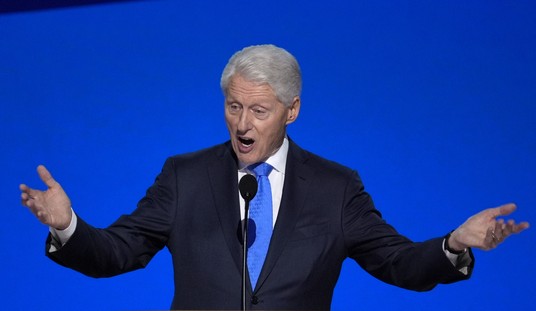More NIE dissent. Is there anyone out there in Iran’s orbit who believes, with high confidence, that they really have suspended their weapons program? The crack U.S. intel community seems to be out on a limb with this one.
Well, actually, that’s not true. Iran’s stooge thinks we’re right on the money, doesn’t he?
According to the [National Council of Resistance of Iran], Iran’s Supreme National Security Council decided to shut down its most important center for nuclear-weapons research in eastern Tehran, called Lavisan-Shian, in August 2003.
The NCRI, which claims to have intelligence sources inside Iran, said Lavisan was broken into 11 fields of research, including development of a nuclear trigger and of the technology to shape weapons-grade uranium into a warhead. But at the same meeting, the council decided to disperse pieces of the research to a number of locations around Iran, according to the NCRI. By the time international nuclear inspectors were allowed to get access to the Lavisan site, the buildings allegedly devoted to nuclear research had been torn down and the ground bulldozed…
Equipment was relocated first from Lavisan-Shian to another military compound in Tehran’s Lavisan district, the Center for Readiness and Advanced Technology, Mr. Mohaddessin said. Two devices designed to measure radiation levels were moved to Malek-Ashtar University in Isfahan and to a defense ministry hospital in Tehran, he said. Other equipment was sent to other locations the NCRI hasn’t been able to identify, he said.
“Their strategy was that if the IAEA found any one piece of this research program, it would be possible to justify it as civilian. But so long as it was all together, they wouldn’t be able to,” Mr. Mohaddessin said.
Strike one: The NCRI is the political wing of the Mujahedeen e-Khalq, listed among the State Department’s list of official terrorist groups since 1997 although the MEK seems to have cleaned up its act a bit lately. Strike two: NCRI’s previous Iranian intel scoops have a mixed record of accuracy. Strike three: Their one blockbuster intel coup, the revelation of the Natanz enrichment facility in 2002, might not have been their scoop at all but may in fact have originated with … the crack U.S. intel community. Big grain of salt, then. On the other hand, NCRI’s claim about a temporary suspension in 2003 followed by the program being quietly restarted at a later date does jibe with Ehud Barak’s own estimates. Which, of course, to some will be all the more reason to doubt it.
Incidentally, much of the new NIE data was gathered by intel agencies at the Pentagon, where the leadership is much relieved at the military option now effectively being off the table. Quote: “Pentagon officials made it clear that this was not a political move by the brass — that the military’s lack of desire for another conflict and the conclusions of the new NIE are coincidental. They stress that the military focuses on ‘intentions, not capabilities’ when assessing threats, and that the final unclassified portion of the NIE warns that the intelligence community believes ‘with high confidence that Iran has the scientific, technical and industrial capacity eventually to produce nuclear weapons if it decides to do so.'”
Update: Ahmadinejad hints that in light of the U.S. climbdown, he might just be open to a grand bargain if we “make a serious change in position in the region,” i.e. scale back support for Israel and withdraw from Iraq.
Update: They’ve got 3,000 centrifuges now, which, operating at peak efficiency, can produce enough highly-enriched uranium to make one bomb in a year. Ahmadinejad’s goal? 50,000 centrifuges within five years.







Join the conversation as a VIP Member